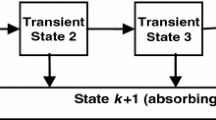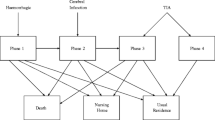Abstract
Optimising resources in healthcare facilities is essential for departments to cope with the growing population’s requirements. An aspect of such performance modelling involves investigating length of stay, which is a key performance indicator. Stroke disease costs the United Kingdom economy seven billion pounds a year and stroke patients are known to occupy long periods of time in acute and long term beds in hospital as well as requiring support from social services. This may be viewed as an inefficient use of resources. Thrombolysis is a therapy which uses a clot-dispersing drug which is known to decrease the institutionalisation of eligible stroke patients if administered 3 h after incident but it is costly to administer to patients. In this paper we model the cost of treating stroke patients within a healthcare facility using a mixture of Coxian phase type model with multiple absorbing states. We also discuss the potential benefits of increasing the usage of thrombolysis and if these benefits balance the expense of administering the drug.









Similar content being viewed by others
References
Akaike H (1974) A new look at the statistical model identification. IEEE T Automat Contr 19(6):716–723
Assmussen S, Nerman O, Olsson M (1006) Fitting phase-type distributions via the EM algorithm. Scand J Stat 23:419–441
Bebbington A, Darton R, Netton A (2001) Care homes for older people: volume 2 admissions, needs and outcomes, The 1995–96 National Longitudinal Survey of Publicly-funded Admissions Edn, Personal Social Services Research Unit, University of Kent at Canterbury
Caulkins JP, Dietze P, Ritter A (2007) Dynamic Compartmental model of trends in Australian drug use. Health Care Manag Sci 10:151–162
Christodoulou G, Taylor GJ (2001) Using a continuous time hidden Markov process, with covariates, to model bed occupancy of people aged over 65 years. Health Care Manag Sci 4:21–24
Cochran JK, Bharti A (2006) Stochastic bed balancing of an obstetrics hospital. Health Care Manag Sci 9:31–45
Dempster AP, Laird NM, Rubin DB (1977) Maximum likelihood from incomplete data via the EM algorithm. J R Stat Soc Ser B 39(1):1–38
Department of Health (2009) NHS Choices: Your Health, Your Choice: Overview Department of Health, http://www.nhs.uk/NHSEngland/thenhs/about/Pages/overview.aspx. Accessed 24/01/11
Department of Health (2008) NHS Institute for Innovation and Improvement. Department of Health, http://www.institute.nhs.uk/. Accessed 25/01/11
Department of Health (2008) NHS Institute for Innovation and Improvement: Performance Management. Department of Health, http://www.institute.nhs.uk/quality_and_service_improvement_tools/quality_and_service_improvement_tools/performance_management.html. Accessed 25/01/11
Fackrell M (2009) Modelling healthcare systems with phase-type distributions. Health Care Manag Sci 12:11–26
Faddy MJ, McClean SI (1999) Analysing data on lengths of stay of hospital patients using phase-type distributions. Appl Stoch Model Bus Ind 15:311–317
Faddy MJ, McClean SI (2005) Markov Chain Modelling for geriatric patient care. Methods Inf Med 44:369–373
Garg L, McClean SI, Meenan BJ, El-Darzi E, Millard PH (2009) Clustering patient length of stay using mixtures of Gaussian models and phase type distributions. 22nd IEEE Symposium on Computer-Based Medical Systems (CBMS 2009), Albuquerque, New Mexico, USA, August 3–4, 2009, pp 1–7
Garg L, McClean S, Meenan, B and Millard P (2009) A phase type survival tree model for clustering patient Length of Stay. Applied Stochastic Models and Data Analysis. The XIII International Conference, Vilnius, Lithuania, pp 477
Garg L, McClean S, Meenan B, Millard P (2010) A non-homogeneous discrete time Markov model for admission scheduling and resource planning in a cost or capacity constrained healthcare system. Health Care Manag Sci 13:155–169
Green PJ (1987) Penalized likelihood for general semi-parametric regression models. Int Stat Rev 55:245–259
Harper PR (2002) A Framework for Operational Modelling of Hospital Resources. Health Care Manag Sci 5:165–173
Harrison GW (2001) Implications of mixed exponential occupancy distributions and patient flow models for health care planning. Health Care Manag Sci 4:35–45
Jones PW, Smith P (2001) Stochastic processes: an introduction. Arnold, London
Latouche G, Ramaswami V (1999) Introduction to matrix analytic methods in stochastic modelling. SIAM, Philadelphia
McClean SI, McAlea B, Millard PH (1998) Using a Markov reward model to estimate spend down costs for a geriatric department. J Oper Res 49:1021–1025
McClean SI, Millard P (2007) Where to treat the older patient? Can Markov models help us better understand the relationship between hospital and community care? J Oper Res Soc 58:255–261
McClean SI, Millard PH (1998) A Three compartment model of the patient flows in a geriatric department: a decision support approach. Health Care Manag Sci 1:159–163
McClean S, Barton M, Garg L, Fullerton K (2011) Combining markov models and discrete events simulation to plan stroke patient care. Transactions on Modeling and Computer Science (TOMACS) 21(4)
McClean S, Faddy M, Millard P (2005) Markov model-based clustering for efficient patient care. Proceedings of the 18th IEEE symposium on computer-based medical systems IEEE, Piscataway, pp 467
Marshall AH, McClean SI (2004) Using Coxian Phase-type distributions to identify patient characteristics for duration of stay in hospital. Health Care Manag Sci 7:285–289
Marshall AH, McClean SI (2003) Conditional phase-type distributions for modelling patient length of stay in hospital. Int Trans Oper Res 10:565–576
Marshall AH, McClean SI, Millard PH (2004) Addressing bed costs for the elderly: a new methodology for modelling patient outcomes and length of stay. Health Care Manag Sci 7:27–33
Marshall A, Vasilakis C, El-Darzi E (2005) Length of stay-based patient flow models: recent developments and future directions. Health Care Manag Sci 8:213–220
Marshall AH, Zenga M (2009) Recent developments in fitting coxian phase-type distributions in healthcare. Applied stochastic models and data analysis. The XIII International Conference, Vilnius, Lithuania, pp 482
Millard PH (1989) Geriatric medicine: a new method of measuring bed usage and a theory for planning, MD thesis, University of London
Neuts MF (1981) Matrix-geometric solutions in stochastic models: an algorithmic approach. John Hopkins University Press, Baltimore
Norris JR (1998) Markov chains. Cambridge Series in Statistical and Probabilistic Mathematics. Cambridge University Press, Cambridge, England
Olsson M (1996) Estimation of phase-type distributions from censored data. Scand J Stat 23:443–460
Royal College of Physicians National Sentinel Stroke Audit Report (2008) Audit of stroke, prepared for on behalf of the Intercollegiate Stroke Working Party, London, RCP
Saka O, McGuire A, Wolfe C (2009) Cost of stroke in the United Kingdom. Age Ageing 38:27–32
Sandercock P, Berge E, Dennis M, Forbes J, Hand P, Kwan J, Lewis S, Lindley R, Neilson A, Wardlaw J (2004) Cost-effectiveness of Thrombolysis with Recombinant Tissue Plasminogen Activator for Acute Ischemic Stroke Assessed by a Model Based on UK NHS Costs 1490–1497
Sundburg G, Bagust A, Terent A (2003) A model for costs of stroke service. Health Policy 63:81–94
Taylor G, McClean S, Millard P (1998) Continuous time Markov model for geriatric patient behaviour. Appl Stoch Model Data Anal 13:315–323
The National Institute of Neurological Disorders and Stroke rt-PA Stroke Study Group (NINDS) (1995) New Engl J Med 33:1581–1588
The NHS Confederation (2010) On the Day Briefing- 2010 Budget Report, The NHS Conderation,http://www.nhsconfed.org/Documents/budget_2010_briefingmarch10.pdf
Xie H, Chaussalet TJ, Millard PH (2006) A Model based approach to the analysis of patterns of length of stay in institutional long-term care. IEEE Trans Inf Tech Biosci 10:512–551
Acknowledgements
The authors acknowledge support for this work from the Engineering and Physical Sciences Research Council (Grant References EP/E019900/1 and GR/S29874/01).
Any views or opinions presented herein are those of the authors and do not necessarily represent those of RIGHT or MATCH, their associates or their sponsors. Support has also been received from the Northern Ireland Health and Social Care Research & Development (HSC R&D) Office.
Author information
Authors and Affiliations
Corresponding author
Rights and permissions
About this article
Cite this article
Gillespie, J., McClean, S., Scotney, B. et al. Costing hospital resources for stroke patients using phase-type models. Health Care Manag Sci 14, 279–291 (2011). https://doi.org/10.1007/s10729-011-9170-y
Received:
Accepted:
Published:
Issue Date:
DOI: https://doi.org/10.1007/s10729-011-9170-y




